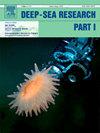中印度脊海山一种新型深海珊瑚的进化亲缘性及其与太平洋物种的联系
IF 2.1
3区 地球科学
Q2 OCEANOGRAPHY
Deep-Sea Research Part I-Oceanographic Research Papers
Pub Date : 2025-06-16
DOI:10.1016/j.dsr.2025.104543
引用次数: 0
摘要
victororggiidae Moore等人,2017包括深海柳珊瑚,其典型特征是紫色的群落和在其水螅触须上独特的josephinae棒。尽管如此,这个家族的物种多样性很低,来自印度洋深处的物种仍然鲜为人知,这表明需要更多的研究来更好地了解它们的生态作用和进化历史。一新种victororggia indica sp. nov.在印度洋中部山脊(CIR)深处1917-2053米的海底山上被发现,这是在印度洋首次记录到victororgorgiidae。在已知的9个victorgorggia (López-González and Briand, 2002)种中,V. indica sp. nov.在形态上与V. flabellata Li et al., 2020和V. iocasica Li et al., 2020最相似,特别是花萼的排列方式,花萼主要分离在枝的三面。然而,这种安排在一个群体的不同部分可能会有所不同,并可能受到当地栖息地条件的影响。与这些种的不同之处在于在触手轴上有有结核的茎,刺棒和弯曲的小茎,在小叶尖的边缘有高的结节。利用MutS样蛋白(MutS -like protein, MutS)基因在家族水平上进行系统发育分析,支持vicorgorgiidae为单系类群。新的CIR物种的进化关系表明其与太平洋同系物(包括V. flabellata, V. iocasica和V. eminens Moore等,2017)有密切的亲缘关系。这表明CIR海底山系统可能作为印度洋和太平洋之间基因流动的纽带。对这些物种繁殖的分析表明,印度浮藻是一种孵卵动物,浮藻幼虫在成团的自生动物(唯一成熟的珊瑚虫)中发育,并定居在死的深海珊瑚上。本文还报道了印度血吸虫线粒体基因组全长18715个碱基对,包括14个蛋白质编码基因(PCGs)、2个核糖体RNA基因(rrnS和rrnL)和1个转移RNA基因。有丝分裂基因组的基因顺序与其他有丝分裂科物种相同。本文章由计算机程序翻译,如有差异,请以英文原文为准。
Evolutionary affinity of a novel deep-sea coral from the Central Indian Ridge seamount, and its links to Pacific Ocean species
The family Victorgorgiidae Moore et al., 2017 comprises deep-sea gorgonian corals typically characterized by purple colonies and distinctive josephinae clubs in their polyp tentacles. Despite this, the family exhibits low species diversity and the ones from the deep Indian Ocean remain poorly unknown, remarking the need for more research to better understand their ecological role and evolutionary history. A new species, Victorgorgia indica sp. nov., was discovered on a seamount along the Central Indian Ridge (CIR) at depths of 1917–2053 m, representing the first record of Victorgorgiidae in the Indian Ocean. Among the nine known species of Victorgorgia López-González and Briand, 2002), V. indica sp. nov. is morphologically most similar to V. flabellata Li et al., 2020 and V. iocasica Li et al., 2020, particularly in the arrangement of the calyx, which is mainly isolated in three sides of the branches. However, this arrangement can vary in different parts of a colony and may be influenced by local habitat conditions. V. indica sp. nov. differs from these species by having tuberculate rods, a thorn club in the tentacle rachis, and curved rodlets with tall tubercules along their edges in the pinnules. Phylogenetic analysis at the family level using the MutS-like protein (MutS) gene supports Victorgorgiidae as a monophyletic group. The evolutionary relationships of the new CIR species suggest a close affinity with its Pacific Ocean congeners, including V. flabellata, V. iocasica and V. eminens Moore et al., 2017. This points to the CIR seamount system potentially acting as a link for gene flow between the Indian and Pacific Oceans. Analyses of the reproductions of these species showed that V. indica sp. nov. is a brooder, with planula larvae developing within clumped autozooids—the only mature polyps—and settling on dead deep-sea coral. Here we presented also the complete mitochondrial genome of V. indica sp. nov., which is 18,715 base pairs in size, and includes 14 protein-coding genes (PCGs), two ribosomal RNA genes (rrnS and rrnL), and one transfer RNA gene. The gene order of the mitogenome is identical to that of other sequenced Victorgorgiidae species.
求助全文
通过发布文献求助,成功后即可免费获取论文全文。
去求助
来源期刊
CiteScore
4.60
自引率
4.20%
发文量
144
审稿时长
18.3 weeks
期刊介绍:
Deep-Sea Research Part I: Oceanographic Research Papers is devoted to the publication of the results of original scientific research, including theoretical work of evident oceanographic applicability; and the solution of instrumental or methodological problems with evidence of successful use. The journal is distinguished by its interdisciplinary nature and its breadth, covering the geological, physical, chemical and biological aspects of the ocean and its boundaries with the sea floor and the atmosphere. In addition to regular "Research Papers" and "Instruments and Methods" papers, briefer communications may be published as "Notes". Supplemental matter, such as extensive data tables or graphs and multimedia content, may be published as electronic appendices.

 求助内容:
求助内容: 应助结果提醒方式:
应助结果提醒方式:


